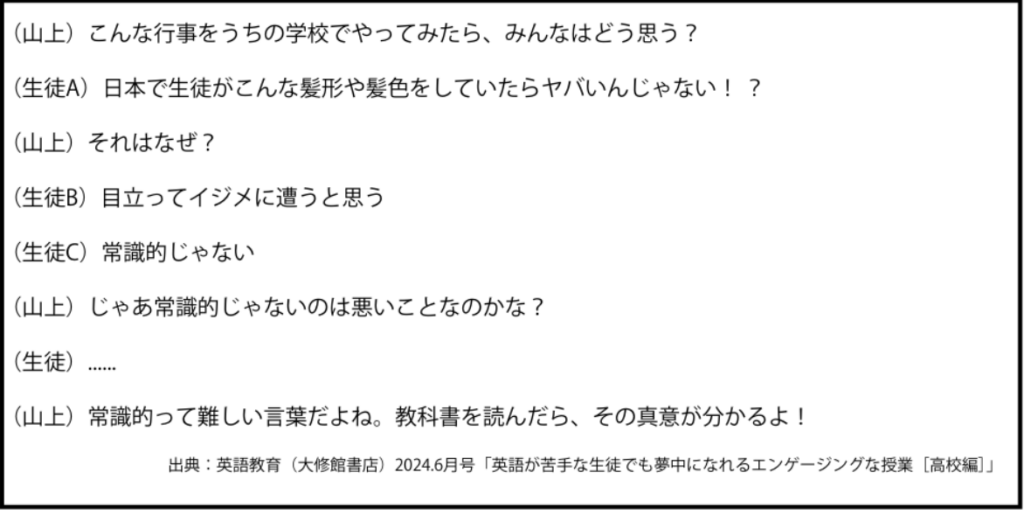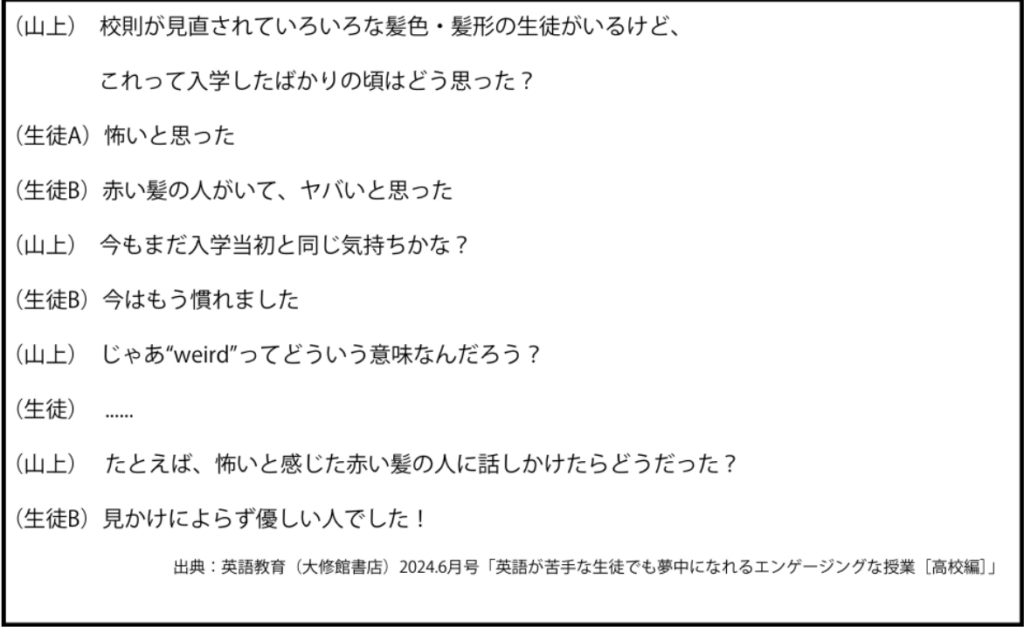My Interview on Classroom Engagement
I was interviewed about strategies to enhance engagement in English the classroom. Here is the English translation of the interview I did in Japanese (https://kknavi.jp/class/12518/). I appreciate the valuable opportunity given to me by 国際教育ナビ!
The Key to Improving Engagement is "Emotional Stimulation"
Q: What strategies have you used to engage students who are not highly motivated to learn English?
Toru: At Sapporo Shinyo High School, where I taught, there were many students who would say, "I don’t want to study English!" Among them, what I especially focused on was the introduction part of the class. If students find the class boring right from the beginning, it becomes difficult to capture their attention later, no matter how great the activities or preparation are. I believe that to increase engagement and help students immerse themselves in the class, it’s crucial to trigger their emotional interest at the start.
Q: What do you mean by "triggering emotional interest"? Can you explain specifically?
Toru: For example, when I used a textbook passage about the American school event "Pajama Day" in an English class, I made efforts to spark emotional interest among the students.

By asking questions that connect to students' own experiences and daily lives, they can increase their interest and engagement in the class content. I believe the key to a successful class lies in whether you can spark emotional interest (emotional engagement) during the initial introduction.
Q: Did you implement any other strategies in your classes?
Toru: One approach I used was increasing opportunities for students to be exposed to English and actively showing them my own use of English. Specifically, I made sure to use English during classes as much as possible. For example, I used an app called "UDTalk," which displayed the Japanese translation of what I was saying in English on a projector. This way, students could follow along and understand the content without anyone feeling left behind. Since my English skills were not perfect, there were times when the translations would show my incorrect grammar, which made the mistakes clear. However, I found that making those mistakes visible helped students realise that "even the teacher makes mistakes," which, in turn, prevented a decrease in their motivation.
I also tried to reduce the gap between students’ current self and their ideal self of the future to prevent a drop in motivation. I would regularly communicate to students that "it's okay not to be perfect, and I am not perfect either" through concrete examples.
Q: It’s true that if students feel it’s okay to make mistakes, it lowers the psychological barriers to learning English.
Toru: Exactly. I would often tell my students, "It's enough if you can understand 30% without translation." While the class was mostly conducted in English, I would provide Japanese support if students were at a disadvantage. Still, I made sure to maximize their exposure to English as much as possible.
I also created opportunities for students to interact with native English speakers. For example, I invited American high school students to Sapporo Shinyo High School or arranged for international students from a Japanese language school where my university classmate worked to visit.
However, I noticed that when interactions were limited to native English speakers, some students felt discouraged, thinking "I can’t speak English at all." To avoid this, I invited people from countries where English is spoken as a second language (e.g., Senegal, Guinea, Burundi) to expose students to different varieties of English. By doing so, I helped them break the fixed mindset of "I have to speak English like a native speaker," which became an opportunity to boost their motivation.
Enhancing Engagement: The Need for Individualised Approaches
Q: Were the students already engaged in the classes before you started teaching them?
Toru: No, at first there was a pervasive sense of "English classes are really boring." Many students even questioned "Why am I taking this class?" and most didn’t have any desire to go abroad or work overseas.
In this environment, I made an effort to increase engagement by stimulating their emotions at the start of the class and choosing topics that students could relate to. At the same time, I also considered the individual motivations of each student. Some students were learning English for exams, some thought "it’s cool to be good at English," and others simply wanted to become better at English. Since the motivations for learning English vary from person to person, I believe that focusing on these individual factors ultimately helps increase engagement.
Q: Indeed, people's motivations for learning English can differ.
Toru: Yes, it's natural because students come from different family environments, have different relationships, and carry various experiences and backgrounds. This diversity shapes the class in school. I’ve always been interested in "motivation and drive," and have conducted research focused on theoretical aspects. However, when I entered the classroom, I found that many external factors were intertwined in a complex way, and things didn’t go as planned. I experienced setbacks.
My one-sided view didn’t work at all. That made me rethink, "As a teacher, what can I do?" and after much trial and error, I believe I’m now able to conduct better classes (though I’m still working on it...).
Q: It’s surprising to hear that even you had moments of trial and error.
Toru: In the beginning, things didn’t go well at all. I personally didn’t like learning English, and when I was a student, I thought the textbooks were boring. I didn’t want my students to feel the same way, so I tried to introduce different things into my classes, stepping away from the textbook. However, the results weren’t as I expected.
That’s when I received advice from senior teachers and decided to revisit the textbook carefully. By doing so, I was able to understand the publisher's intentions and realised, "Actually, the textbook isn’t so bad." I came to appreciate it.
From then on, I started conducting classes using the textbook, especially focusing on the three stages: "Introduction," "Deepening," and "Advancement."
- Introduction: Stimulating student interest.
- Deepening: Asking questions to encourage deeper understanding.
- Advancement: Encouraging students to relate what they’ve learnt to themselves and develop their own opinions.
Q: Could you explain more about the three points you focused on?
Toru: For example, let's say we are teaching the meaning of the word "weird." The Introduction would involve engaging students through questions, such as, "Isn’t common sense difficult?" to spark their interest in the class itself.
In the Deepening phase, I would ask questions to connect the word "weird" to their everyday lives.

Q: In the development phase, how did you encourage the students to engage further?
Toru: In the development phase, I had the students discuss the theme of "strange but valuable actions" in small groups of 3 to 4 people. I provided support while encouraging them to present their thoughts actively in English. This approach not only allowed them to speak with enthusiasm but also boosted the class’s overall willingness to take on challenges, which significantly enhanced engagement.
Q: Were there any other key aspects you focused on in your lessons?
Toru: Yes, in all three stages—Introduction, Deepening, and Advancement—I kept four key aspects of engagement in mind:
- Emotional Engagement
- Behavioural Engagement
- Cognitive Engagement
- Social Engagement
In simple terms, engagement is essentially a state of "being immersed" in the class. Engagement is made up of both external factors, such as actions, and internal factors, such as emotions, and I made sure to consider both aspects.
For example, when I was younger, I used to raise my hand a lot in class. From an outside perspective, one might think, "This student is highly engaged." However, internally, I knew that as long as I raised my hand enough, I wouldn’t be called on again, which is why I kept raising my hand.
In other words, just because I was raising my hand (an external action) doesn’t mean I was engaged or motivated internally. To avoid this, I made sure my classes provided topics that would stimulate cognitive engagement, and then followed up with discussions and presentations to encourage behavioural engagement.
For Teachers Working to Enhance Student Engagement
Q: Message to Teachers Who Want to Implement Engaging Classes?
Toru: One thing that has caught my attention recently is how strongly students feel that their sense of agency is being evaluated by teachers. There are times when I wonder if students are genuinely being proactive or merely acting like they are to be judged on their perceived level of engagement. This can sometimes lead to a situation where students exhibit "forced agency," simply doing things to fulfill expectations rather than out of intrinsic motivation.
To truly foster real agency in students, I believe it is important to create a structured framework in which tasks are designed thoughtfully. By setting clear goals and allowing students the freedom to engage with the material in meaningful ways, we can help cultivate authentic motivation.
If you're interested in exploring this further, I encourage you to check out the book "Promoting Engagement in English Classrooms: Connecting Motivation and Action with a New Motivational Concept ," which I contributed to. It explores in greater depth how to foster genuine engagement and motivation in the classroom!

